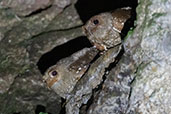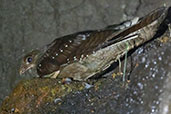
The Oilbird is distributed from Panama and Colombia through Venezuela to Trinidad and Guyana and south through Ecuador, Peru and Bolivia. See the distribution map at Birdlife International. A nocturnal bird it forages in primary tropical and subtropical forests while it roosts during the day in nearby caves and can be found as high as 3,400 metres.

Their oily diets cause the fledglings to gain a great deal of weight until they can be 50% heavier than their parents. The indigenous people used to catch the youngsters and boil them to extract this oil which they used mainly for cooking but also for oil lamps - hence the English name.

| Previous Page | Back to Index | Next Page |